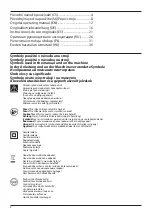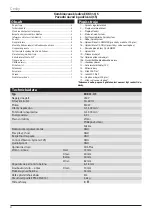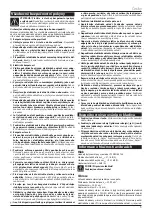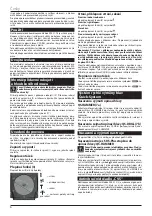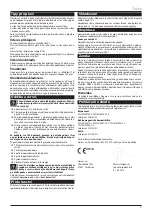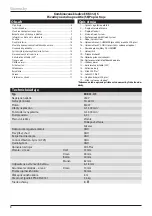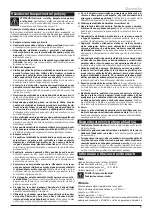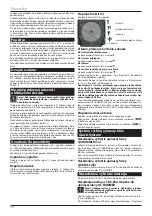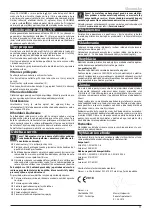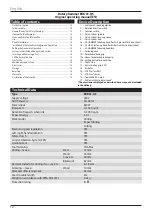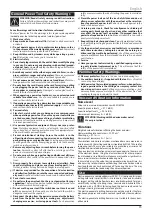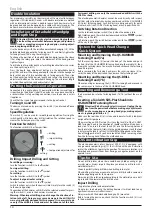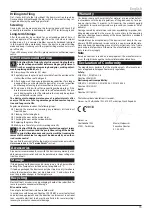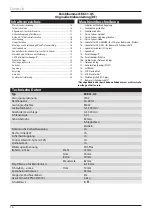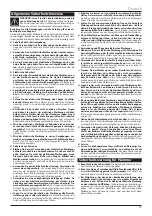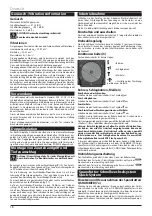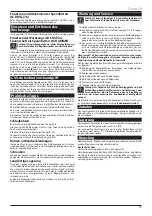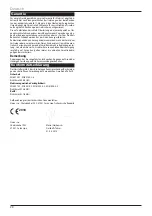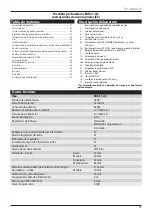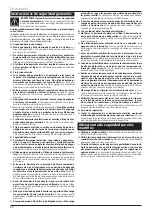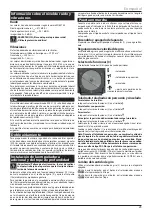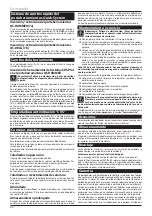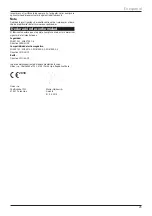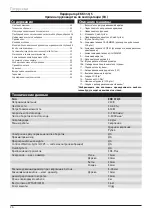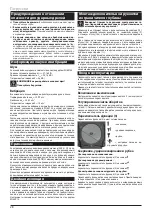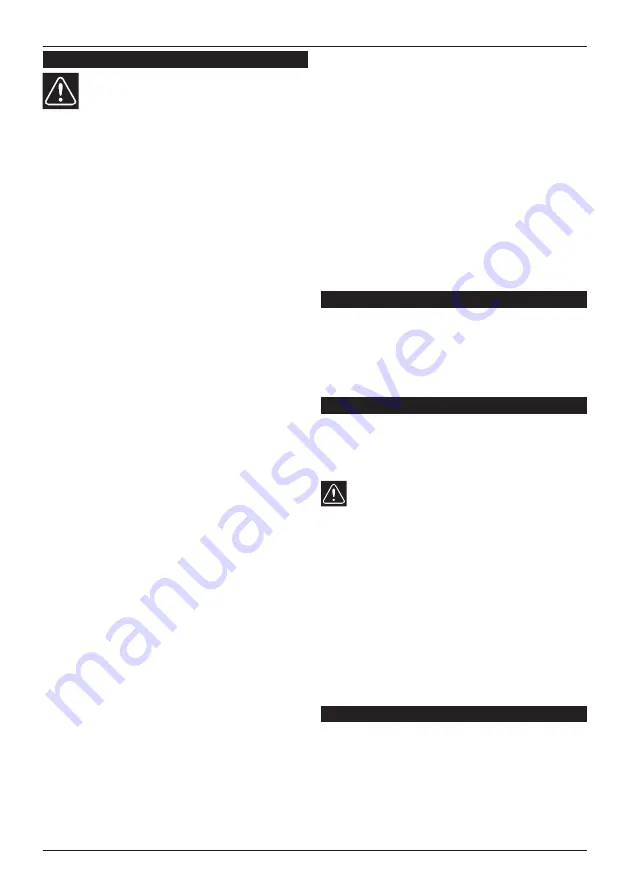
English
13
General Power Tool Safety Warnings
WARNING! Read all safety warnings and all instructions.
Failure to follow the warnings and instructions may result
in electric shock, fire and/or serious injury.
Save all warnings and instructions for future reference!
The term “power tool” in the warnings refers to your mains‑operated
(corded) power tool or battery‑operated (cordless) power tool.
1) Work area safety
a)
Keep work area clean and well lit.
Cluttered or dark areas invite
accidents.
b)
Do not operate power tools in explosive atmospheres, such as
in the presence of flammable liquids, gases or dust.
Power tools
create sparks which may ignite the dust or fumes.
c)
Keep children and bystanders away while operating a power
tool.
Distractions can cause you to lose control.
2) Electrical safety
a)
Power tool plugs must match the outlet. Never modify the plug
in any way. Do not use any adapter plugs with earthed (ground‑
ed) power tools.
Unmodified plugs and matching outlets will re‑
duce risk of electric shock.
b)
Avoid body contact with earthed or grounded surfaces, such as
pipes, radiators, ranges and refrigerators.
There is an increased
risk of electric shock if your body is earthed or grounded.
c)
Do not expose power tools to rain or wet conditions.
Water en‑
tering a power tool will increase the risk of electric shock.
d)
Do not abuse the cord. Never use the cord for carrying, pulling
or unplugging the power tool. Keep cord away from heat, oil,
sharp edges or moving parts.
Damaged or entangled cords in‑
crease the risk of electric shock.
e)
When operating a power tool outdoors, use an extension cord
suitable for outdoor use.
Use of a cord suitable for outdoor use
reduces the risk of electric shock.
f)
If operating a power tool in a damp location is unavoidable, use
a residual current device (RCD) protected supply.
Use of an RCD
reduces the risk of electric shock.
3) Personal safety
a)
Stay alert, watch what you are doing and use common sense
when operating a power tool. Do not use a power tool while you
are tired or under the influence of drugs, alcohol or medication.
A moment of inattention while operating power tools may result
in serious personal injury.
b)
Use personal protective equipment. Always wear eye protec‑
tion.
Protective equipment such as dust mask, non‑skid safety
shoes, hard hat, or hearing protection used for appropriate con‑
ditions will reduce personal injuries.
c)
Prevent unintentional starting. Ensure the switch is in the
off‑position before connecting to power source and/or battery
pack, picking up or carrying the tool.
Carrying power tools with
your finger on the switch or energising power tools that have the
switch on invites accidents.
d)
Remove any adjusting key or wrench before turning the power
tool on.
A wrench or a key left attached to a rotating part of the
power tool may result in personal injury.
e)
Do not overreach. Keep proper footing and balance at all times.
This enables better control of the power tool in unexpected situa‑
tions.
f)
Dress properly. Do not wear loose clothing or jewellery. Keep
your hair, clothing and gloves away from moving parts.
Loose
clothes, jewellery or long hair can be caught in moving parts.
g)
If devices are provided for the connection of dust extraction
and collection facilities, ensure these are connected and prop‑
erly used.
Use of dust collection can reduce dust‑related hazards.
4) Power tool use and care
a)
Do not force the power tool. Use the correct power tool for your
application.
The correct power tool will do the job better and safer
at the rate for which it was designed.
b)
Do not use the power tool if the switch does not turn it on and
off.
Any power tool that cannot be controlled with the switch is
dangerous and must be repaired.
c)
Disconnect the plug from the power source and/or the battery
pack from the power tool before making any adjustments,
changing accessories, or storing power tools.
Such preventive
safety measures reduce the risk of starting the power tool acciden‑
tally.
d)
Store idle power tools out of the reach of children and do not
allow persons unfamiliar with the power tool or these instruc‑
tions to operate the power tool.
Power tools are dangerous in the
hands of untrained users.
e) M
aintain power tools. Check for misalignment or binding of
moving parts, breakage of parts and any other condition that
may affect the power tool’s operation. If damaged, have the
power tool repaired before use.
Many accidents are caused by
poorly maintained power tools.
f)
Keep cutting tools sharp and clean.
Properly maintained cutting
tools with sharp cutting edges are less likely to bind and are easier
to control..
g)
Use the power tool, accessories and tool bits etc. in accordance
with these instructions, taking into account the working con‑
ditions and the work to be performed.
Use of the power tool for
operations different from those intended could result in a hazard‑
ous situation.
5) Service
a)
Have your power tool serviced by a qualified repair person us‑
ing only identical replacement parts.
This will ensure that the
safety of the power tool is maintained.
Hammer Safety Warnings
a)
Wear ear protectors.
Exposure to noise can cause hearing loss.
b)
Use auxiliary handle(s), if supplied with the tool.
Loss of control
can cause personal injury.
c)
Hold power tool by insulated gripping surfaces, when perform‑
ing an operation where the cutting accessory may contact hid‑
den wiring or its own cord.
Cutting accessory contacting a „live“
wire may make exposed metal parts of the power tool „live“ and
could give the operator an electric shock.
Noise and Vibration Information
Noise Level
Values were measured in accordance with EN 60745.
Acoustic pressure level L
pA
= 87.1 dB (A).
Acoustic output level L
wA
= 98.1 dB (A).
Measurement inaccuracy K = 3 dB (A).
ATTENTION! Working with the device makes noise!
Use ear protection!
Vibrations
Weighted value of vibrations affecting the hands and arms:
Hammer drilling into concrete a
h
= 29.99 m/s
2
.
Chiselling a
h
= 87.1 m/s
2
.
Measurement inaccuracy K = 1.5 m/s
2
.
The vibrations and noise level values mentioned here were measured in
accordance with the testing conditions stipulated by EN 60745 used for
comparing tools. They are also suitable as a preliminary assessment of
vibration and noise load before using the device.
The noise levels and vibration values mentioned apply to the main use
of the electrical device. Using the electrical device for other purposes
than intended, or insufficient maintenance may lead to a significant in‑
crease in noise level or vibration load during work.
To accurately assess the values during a predetermined work time, it is
also necessary to take into account how long the device has been idle or
how long the device has been turned off for during this time. This may
significantly reduce the load during the entire work period.
Use
Electro‑pneumatic combined hammer EKK 31‑QS is designed for impact
drilling with solid (spiral) drill bits into concrete, stone and brickwork,
for impact drilling with hollow hole saws into brickwork and for medi‑
um difficulty cutting into tiling, stone, concrete and brickwork. When
combined with a QS‑DRILL fastening head, the device can be used for
drilling or screwing into wood, metal and plastics.
This electro‑pneumatic drilling hammer can only be used for the afore‑
mentioned purposes and used in contexts specified by the manufactur‑
er.
The electro‑pneumatic drilling hammer is not suitable for heavy dem‑
olition work.


